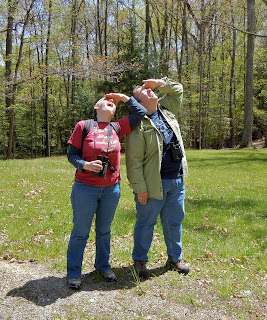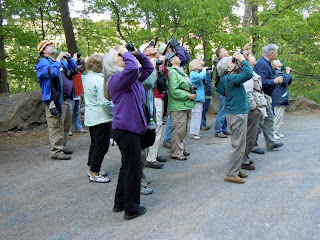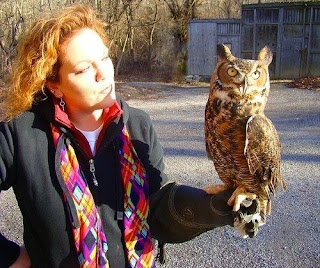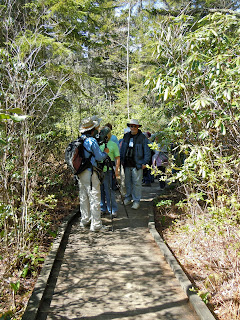
This is your trusty reporter checking in from the New River Birding And Nature Festival, where I have been embedded for a week into a platoon of birders. I am in full birder camo with binoculars and zip-off pants and have undergone training in birder posture, mouth agape and head cranked back in a position known to cause strokes in elderly people. There are plenty of birds that muck about on the ground but we seem to be focusing on warblers in the treetops. Sustained warbler-watching causes a painful condition known as “warbler neck.” (The development of streaky chin feathers is a whole different condition.) This can be alleviated with the purchase of a strap-on neck rest, which has the side benefit of maximizing dorkiness, by which solitary birders can recognize each other and possibly pair off.
In groups, birders tend to bunch up and point skyward, swiveling in unison like the coordinated tentacles of a sea anemone. Any individual tentacle may take responsibility for pointing out a “bird,” which is what they call indistinct flitting movements in the peripheral vision. After that the tentacles operate as a unit.

The group leader is responsible for conjuring up the birds, concentrating on “lifers,” or birds that someone doesn’t already have on his Life List of birds. “What do you need?” the leader will ask, and then track down the target birds somewhere in the vicinity. He or she does this through the use of alert ears and the same slack expression also noted in daydreaming students and schizophrenics. Once the target bird is located by ear, the leader draws him closer by means of an iPod playing the bird’s song, which compels the bird to get right up in his grill and point out that he’s trespassing. This may seem like cheating. That’s because it is cheating, but all the birders get a nice look, and the bird gets a “win” and a boost of confidence when the iPod shuts off.
This is known as “calling in” a bird, and, in fact, even at night, a group of birders can go out with an iPod set on “barred owl,” and, if everyone remains very quiet, call in another group of birders with an iPod set on “barred owl.” It’s marginally satisfying.

Most birders, even the ones not qualified to lead a group, know a lot about birds. Many a time I found myself locked onto a bird, helpfully squeaking
“birdbirdbird,” and someone would materialize behind me with a running narrative about the bird in question, like a proximity-animated audio tour in a museum. And some have specific areas of expertise.
Susan Kailholz-Williams, for instance, is in the raptor-rehabilitation business. Susan walks around with eagles on her wrist. Susan’s first inclination, upon spotting a mouse in her bathtub, is to go fetch one of her handy birds of prey to take care of the issue. If Susan, who has an enormous personality, only some of which is in her shirt, wants to impart some of her wisdom about birds, I intend to listen carefully and say
ma’am, yes ma’am.I was pleased once again to be in a beautiful Eastern deciduous forest, not as fernily voluptuous as an Oregon rain forest, but more diverse in many ways and more likely to host salamanders. There were drawbacks. The woods are not as dense as I’m used to, and a person has to hike a long way to be out of sight of the others. Who are, after all, scanning every inch of the territory with binoculars. So if you were to tip over while peeing (for instance), and gash your knee and soil your left shoe (say), there might not be anyone to help within earshot. (Theoretically.) However, it cannot be ruled out that you would be dead center in a spotting scope with a 30x magnification and under surveillance by a line of twenty fascinated people.
The bunching-up behavior of birders is best observed in a place like Cranberry Glades, a beautiful bog in which human traffic is confined to a narrow boardwalk. The birders bunch up at a warbler sighting, then break up and drift away only to bunch up later next to a waterthrush. Seen from above, and speeded up, they look like an embolism.

Another behavior that might be observed in a clot of birders is the tendency of one or more members to make a “pish-pish” sound in an effort to attract birds. (Collections of British gentlemen, although similar, are distinguished by their ascots and beaks.) So, to recap, we have a group of people behaving in concert like a sea anemone wearing dorky paraphernalia and sounding as though they have sprung a leak. We are not here to judge, people. Remember, birders are human, too, and they may well have a life list, but they do have a life. Also, a list.
I’m listless, but heaven help me, I’ve gone over. Now I’m going to be the person in the car in front of you slaloming over the highway with my head craned out the window looking straight up. Don’t give me that look, Miss Cell Phone Blabbypants.




tears
squirting
out
of
my
EYES!
Hilarious start to my day- thanks
Pisssshhhh pisssshhhh There's a perfect Warbling Murrmur. This friendly little bird generally inhabits the west coast, but has been known to attract flocks of attention when she begins her daily chortlecall. Now on my life list!
So, Murr, when are you hosting one of these wing-dings in your area?
Love this Murr, and your intro "Julie" post. I'm enjoying hearing your voice (and laughter) while I read and relating to my own experience with your wit added! Heavens, if we didn't laugh at ourselves, how would we get through it? Fun murrmurrings about real people and real birding!
Luckily, I had already finished my coffee when I read this, or I would have had some serious screen-cleaning to do. Also, I hate to go all birdy on you, but I think that bling on Susan's wrist is an owl. There could well be eagles in her shirt, though.
Alas, I am not birdy.
Well, maybe not yet. But you sure are Murrful.
Nobody murrier!
"Yippee, another Murr post" I said to myself. Then came "Oh Lord, I can see her (theoretically) tipping over!" (The only time I've done that was under a bridge somewhere in the Smokies waiting for a light to change somewhere in Gatlinburg and I couldn't wait any longer so I got out while my husband inched the car forward a centimeter – don't remember soiling anything, tho!).
I paint with pigment – you paint with words! (And are terrific at it!)
I'm picturing that a pickpocket would have a field day (literally) amongst a flock of birders with all of them their gaze tilted skyward.
I was nudged to your blog by a facebook entry by my cousin, Sara Stratton. Thoroughly enjoyed this post, accurate AND witty. Don't you think Sara is one of the funniest people ever born?! Cheerio
Thank you for providing this rare window into the birding world, so that I can now say that I will NEVER be going there myself.
Thanks for finally explaining the birding world to me, too! After I recovered from reading this and laughing out loud, I realized that I'd better never take you to one of our dog parks out here in the East. Your pen and tongue would probably have a field-day, relating all of the behaviours one sees in that setting…..
No, Murr. MOST of my personality is IN my shirt.
…and, if everyone remains very quiet, call in another group of birders with an iPod set on "barred owl."
I almost soiled my left shoe. Art imitates life.
A long time ago (well, the early '80's), in a galaxy far, far away (well, Miami-Dade County) I was unfortunate enough to serve six months with the South Florida Drug Task Force.
Apart from having to spend a lot of time with cocksure, hyped up and testosterone-soaked young agents, it was still not all that interesting. One of the difficulties was the number of agencies involved, (quickly, off the top of my head) about 5 Federal, 7 State, Several County and heaven only knows how many little municipal police departments (like mine), ranging from the DEA and Coast Guard to — well, dinky little agencies like mine.
Everyone was out trying to make a name for themselves and their departments (see "testosterone," above), and stings, drug buys, surveillances and similar shenanigans were rampant. Seldom did the right pinkie know what the left big toe was doing, nor any of the other digits. The FBI, for example, wouldn't talk to anyone about anything, and the other Federal agencies were just as bad. Add to that the necessary — although often lacking — level of secrecy supposedly attendant upon such furtive, potentially lethal activity, and a certain degree of cross purposes was inevitable.
It got so bad, toward the end, that it wasn't unusual for a couple of agents on a buy to whip out badges and guns only to discover they were arresting other agents. This usually resulted in a disgusted retreat to one of several preferred refuges of the watering-hole variety, where everyone indulged in a law enforcement exercise known as "creative report-writing." As far as I know, no one was ever shot, although there were a few really close calls.
Thanks for a good belly-laugh, and the memories. Every now and again I need to be reminded why I got out of that insane line of work.
Thanks for the best laugh I've had in a while. If the birding gets dull during the next hike I lead, I may have to read excerpts of this post to the birders.
Ladies and gentlemen, a free BONUS blog post from Digitalzen! Thank you, Didge! Sara is a national treasure, albeit not my nation. Debward, not only do I tip over, but I can accurately gauge the downhill slope by working backwards from which of my feet get wet. Robert, you're right about the pickpockets, but they wouldn't get anything. Swamp4me, you're welcome to it, and thanks for the fabbo header photo on your blog!
Ahem…I am going to have to dispute that all the birders were dressed in dorky outfits.
I hereby grant you all with the permission and mission to dress fashionably while in the field.
Sexy and birding can go together!
Manolo Blahniks won't ever be the norm but it is acceptable to wear faux fur and sparkles.
No one said birders have to be dorky. Birding is a cool ass avocation.
Sorry you will miss out on Purple crowned fairy wrens and Cuban Todies Miss Jane.
Poor Jane's daughter! Never to know the Bearded Mountaineer
Ah, I do recall a radiant beauty in faux leopard, a goddess she was; men swooned, birds fanned her face, moths eyed her vest. I stand corrected.
This post will be great to share with friends and family. Kind of like "What to do When Someone You Love is Bipolar."
WOW, what a wonderful humorous and visually pleasing ("word art") description of a typical regimented human birding phenomenon. It's right on and I'm a birder! Fortunately for me I had the privelage to work with 26 kindergartners, and their teachers several years ago at the School in Rose Valley, Moylan, PA. I spent several days a week over a two month period with these little jewels. My roll was to lead them on nature walks and encourage them to record their findings in their nature journals. Of course, birds were on my mind when I committed to the project. On the first day it took about 45 seconds (I'm a slow learner)to realize that the world of nature for a kindergartner resides below the 3 foot level. After the first day I realized that these kids were re-educating me and bringing me back down to earth. Now that we have relocated to California I am looking at the natural world with kindergartner eyes and enjoying it immensely. Thanks again, and you are right – Most things are humorous!
What a wonderful post! I thouroughly enjoyed reading about your adventure. My favorite photos are of the 'geeky birders'! ~karen
I believe I would have some reservations about standing under a tree full of birds and looking up at them with my mouth open. A mama bird might drop you a worm, but I'm betting on some other kind of droppings . . .
Murr, Murr, Murr, you silly goose. Just the photo alone of those people gawking upward cracked me up right away. You are such a breath of fresh air. Did you know my granddaughter lives in Wilsonville? I wonder what might happen if we ever got together and found ourselves on a roll? We very well could highly amuse ourselves for quite some time, I'll bet. I'd love that. I believe you're right out there dangling on the lunatic fringe with the best of humor writers, where only the bold and brave dare to write without fear of being institutionalized. Yer so funny. Thanks for the laughs.
hee hee..You are a silly girl!
Would it seem cheating if an owl were to flip on a TV to attract humans? Actually I could do what you did….I can whisper frantically, "Bird, bird!"
"There could well be eagles in her shirt, though."
*snort*
Another good one, damn it. And in honour of it, I hearby give you the Sunshine Award.
Okay, okay. Truth is, someone who has a particularly unique understanding of my blog, "I Don't Give A Damn," recently gave me the Sunshine Award, which is for "bloggers whose positivity and creativity inspires others in the blog world.” I've dropped the "positivity" part and am passing it along to those who inspire me. Drop by, pick it up, see if any birds respond to it. Susan could always stash it in her shirt, if you want.
Frank, that cracks me up, you getting a positivity award. Well done! My site is, of course, sober discourse in a demure, understated setting, so I will forward my award directly to Susan's shirt, if there's any room left. But with a warm smiley feeling in my innards. Thanks.
I'm enjoying these posts in the same way that I enjoy reading Smithsonian Magazine, but I will never, ever truly understand birding. It's really just a way to meet chicks, isn't it?
Another good one, damn it. And in honour of it, I hearby give you the Sunshine Award.
Okay, okay. Truth is, someone who has a particularly unique understanding of my blog, "I Don't Give A Damn," recently gave me the Sunshine Award, which is for "bloggers whose positivity and creativity inspires others in the blog world.” I've dropped the "positivity" part and am passing it along to those who inspire me. Drop by, pick it up, see if any birds respond to it. Susan could always stash it in her shirt, if you want.
I believe I would have some reservations about standing under a tree full of birds and looking up at them with my mouth open. A mama bird might drop you a worm, but I'm betting on some other kind of droppings . . .
Thanks for finally explaining the birding world to me, too! After I recovered from reading this and laughing out loud, I realized that I'd better never take you to one of our dog parks out here in the East. Your pen and tongue would probably have a field-day, relating all of the behaviours one sees in that setting…..
Thank you for providing this rare window into the birding world, so that I can now say that I will NEVER be going there myself.
Ahem…I am going to have to dispute that all the birders were dressed in dorky outfits.
I hereby grant you all with the permission and mission to dress fashionably while in the field.
Sexy and birding can go together!
Manolo Blahniks won't ever be the norm but it is acceptable to wear faux fur and sparkles.
No one said birders have to be dorky. Birding is a cool ass avocation.
Sorry you will miss out on Purple crowned fairy wrens and Cuban Todies Miss Jane.
Poor Jane's daughter! Never to know the Bearded Mountaineer